June 17 Grotto del Bussento (Day 264)
We rented a car today with the help of the hotel concierge who called the car rental agent who she knows and got us a better deal than we could find online! We were picked up and driven to the rental place where we filled out the paperwork then drove back to the hotel to pick up our daypacks, water, snack food & sunscreen! Off we went up into the hills behind Sapri to find the waterfalls we have read about. Our first stop was in the town of Vibonati at a roadside monument to a priest.

I never found out who the priest was or what his accomplishments were to warrant a statue!

It is a great spot to get a view back down to the Mediterranean!
Continuing up into the hills we found this spot, a medieval bridge over a creek, visible from a newer larger bridge!
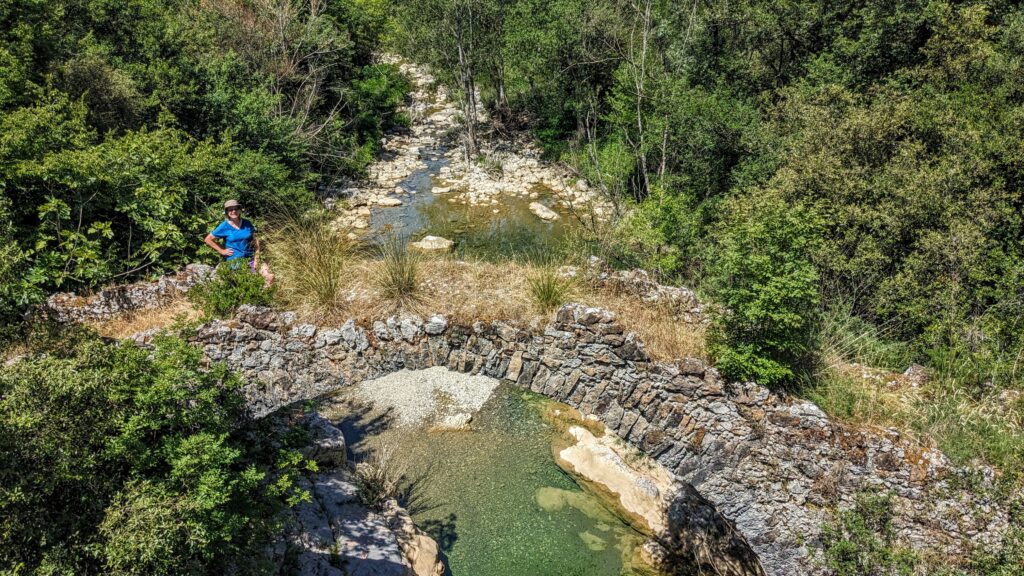
There are trails leading around to the many medieval villages in the hills, the “Farneto Path” which is “Enhancement of the Bussento River and its tributaries through the recovery of a network of paths, incentive for tourist activities”. (Translated from a sign on the path!)
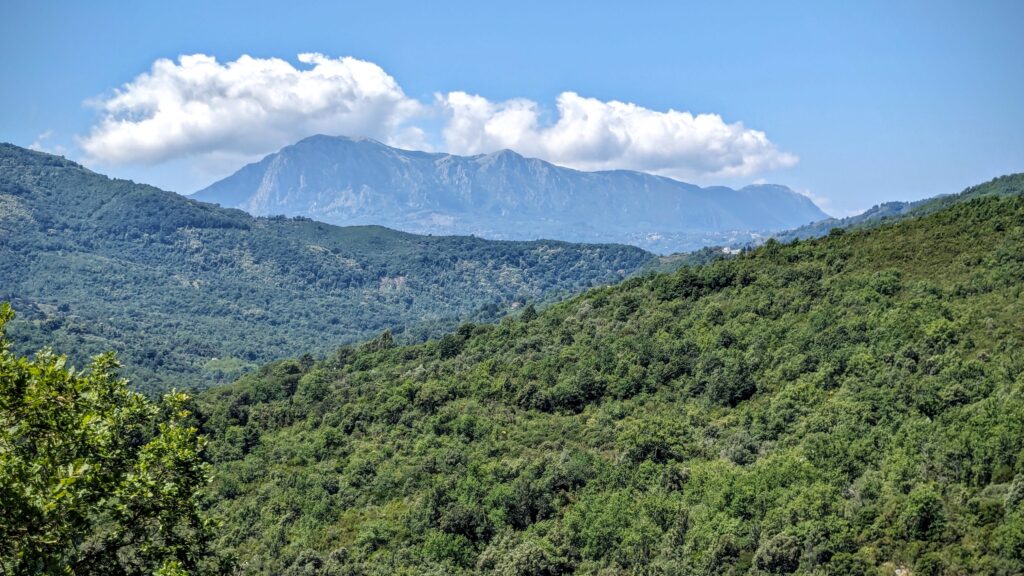
The views as we rose higher into the hills are fantastic!
We finally reached our destination the Oasi WWF Grotte del Bussento, or the Oasis of the Cave of the Bussento (river), within the Cilento and Vallo di Diano National Park. The Bussento River disappears underground somewhere and emerges, icy cold and crystal clear, from the cave we hiked down to. It was hot and humid out and we had a half mile of zigzagging down the hillsides on stone paths and stairs worn smooth by centuries of people and donkeys traveling down the same route! At least we had some shade as we entered forest!
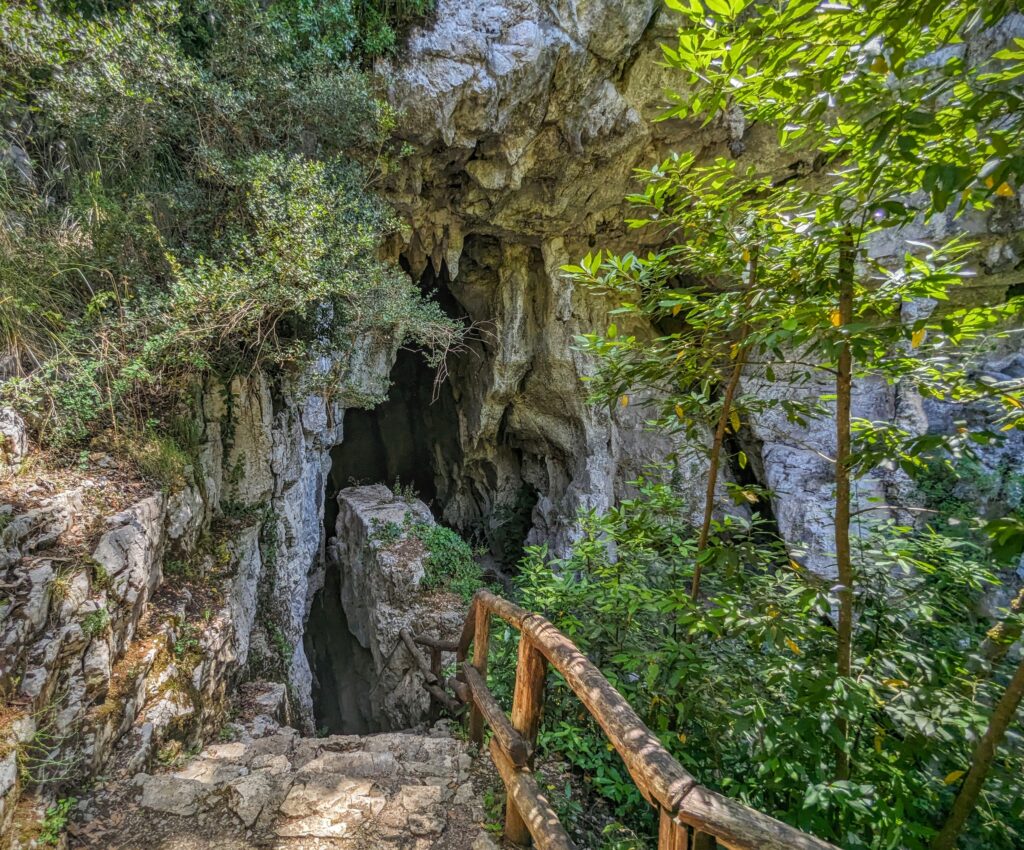
We could feel the cool air and hear the rush of water as we approached the cave entrance. We entered and went down more stairs to see the water so clear that our pictures do not distinguish where the water level is! The cool air rushing out was fantastic natural air conditioning!
Short pathways following the river lead to a grotto of lichen and moss along rushing water flowing over rocks smoothed by eons of erosion! The main path continued towards a medieval era mill that was in use into 1960!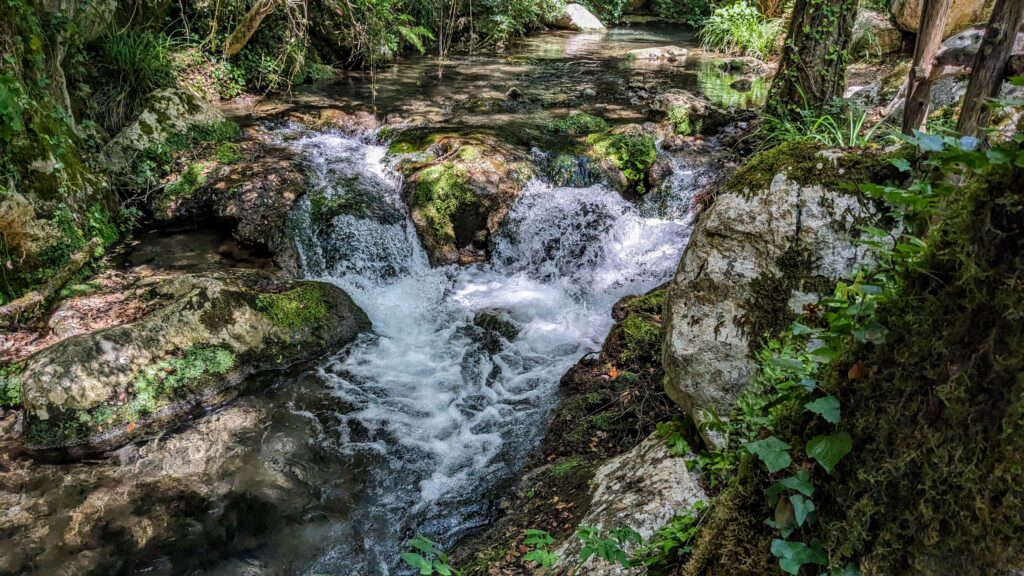
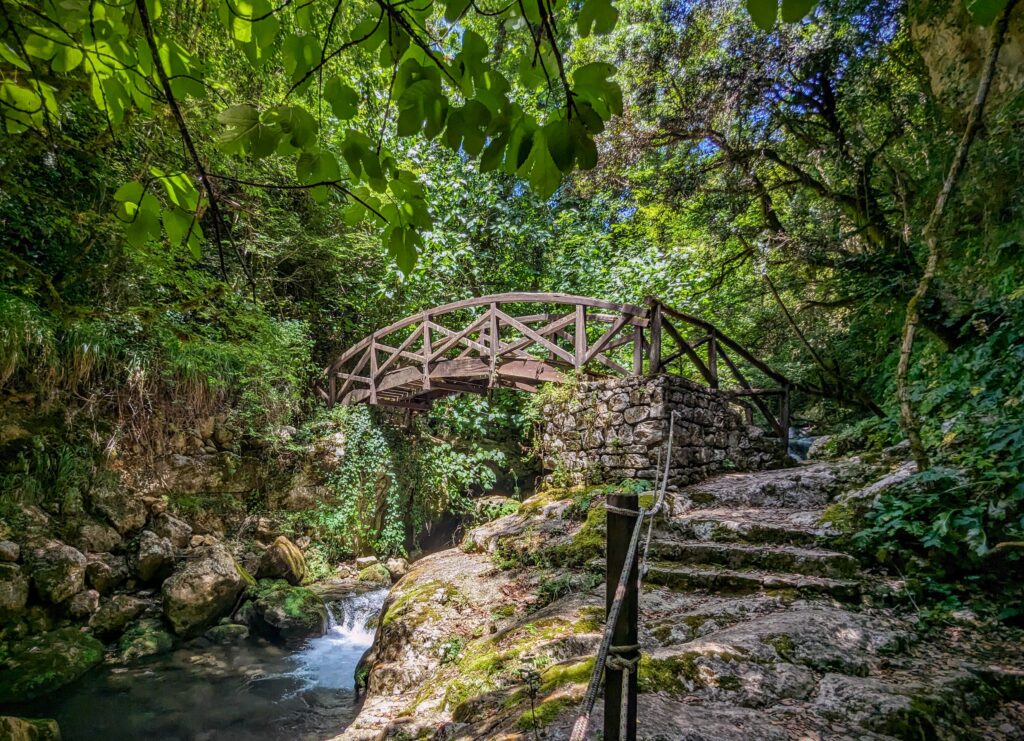
The rustic bridges and rock paths really put you in a medieval setting!
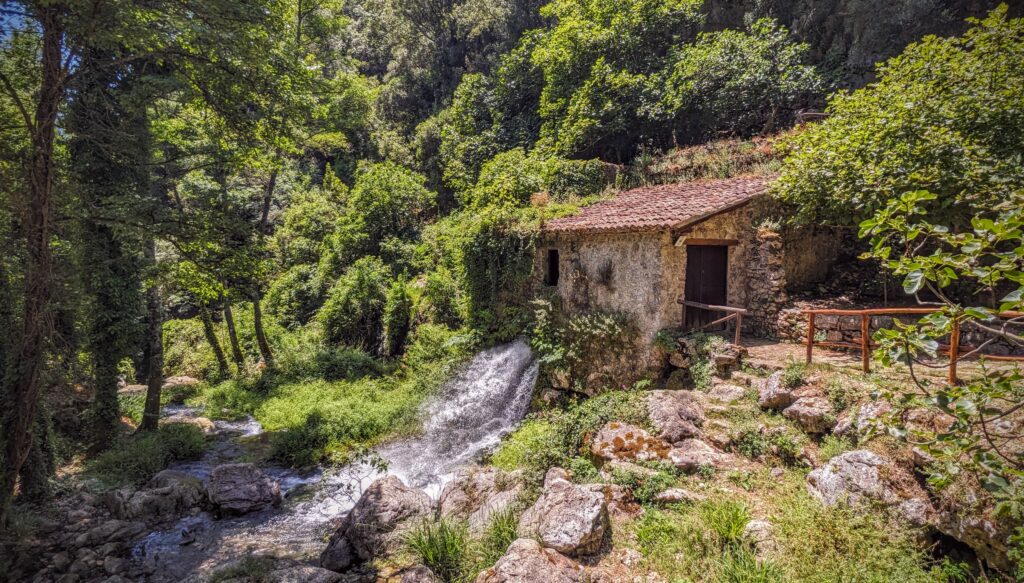
We reached the mill to see water jetting out of the side of the building! We couldn’t go inside to see the mill workings, if they still exist, but we followed the path above the building to see the source of the water, a spring that is channeled down into the building along a stone lined canal.
We were reluctant to leave the oasis of cool water and shady forest but we had to hike back up the donkey path to the car. We continued on our way to the town of Casaletto Spartano where we found a small restaurant and shared a salad and pasta of the day plate!
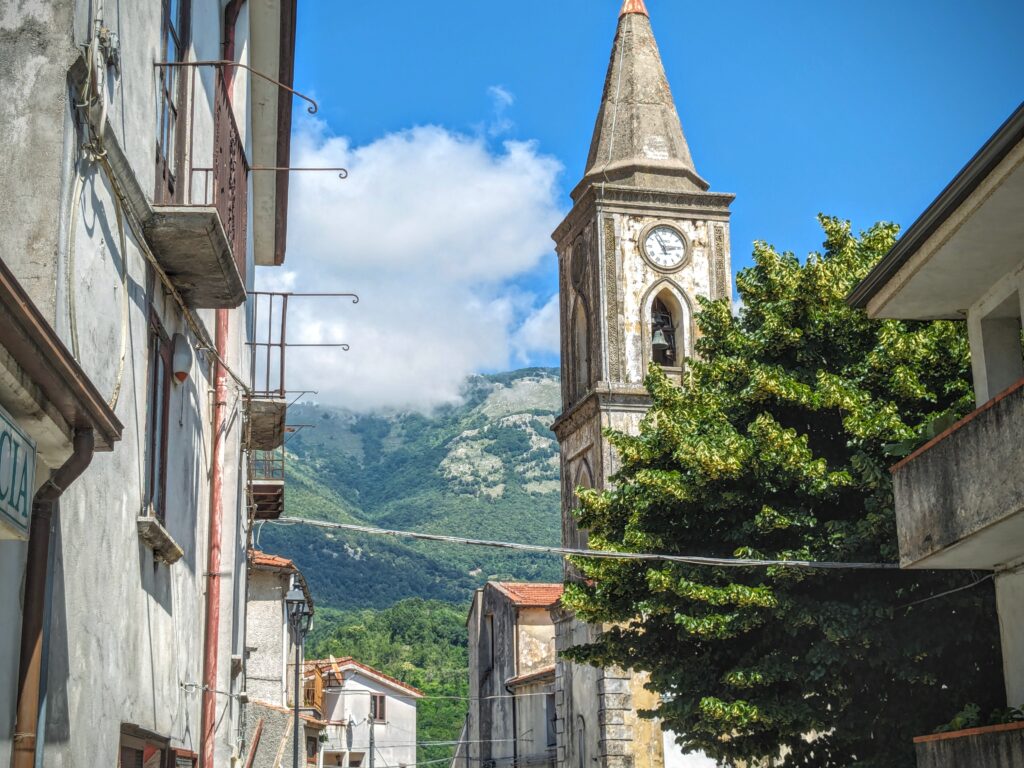
The town is surrounded by mountains!
As we left town we stopped at the natural spring the town is famous for, the ‘Capelli di Venere’, the Hair of Venus Waterfall.
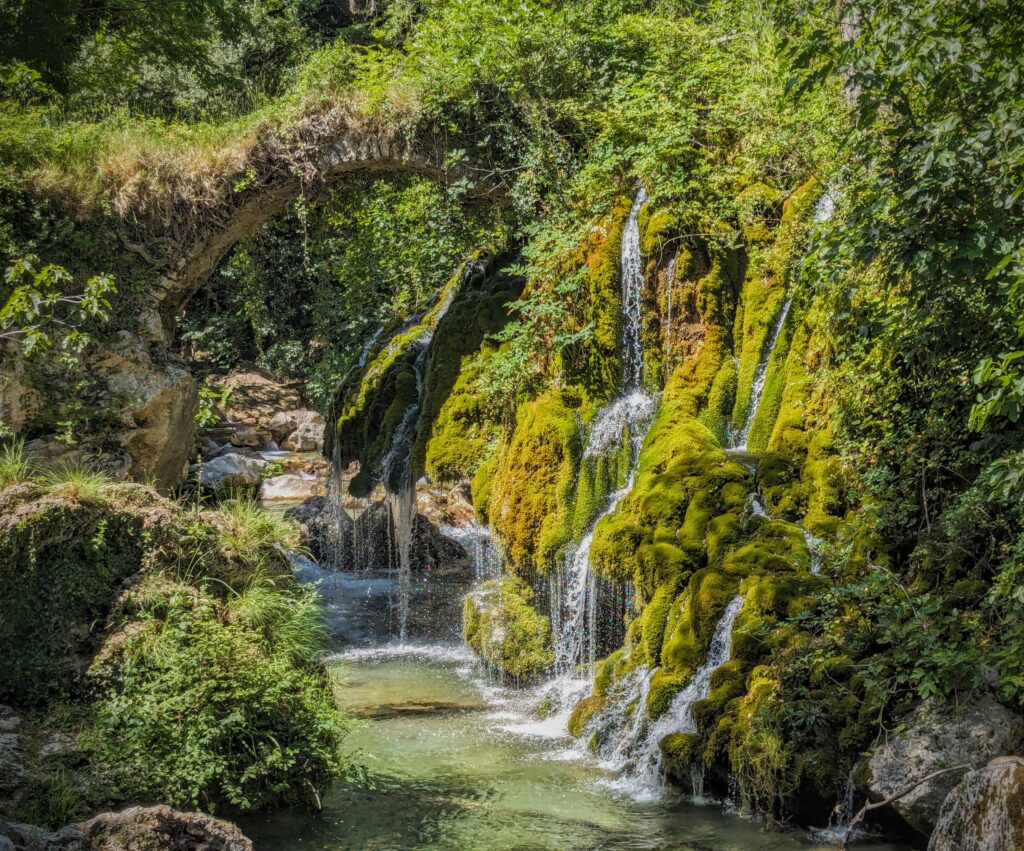
It is a true fairy tale site! It was so bright and sunny out the picture does not do it justice!

The tiny drops of water sparkle in the sunlight like beads of diamonds.
As we turned down the mountain to make a loop back to Sapri we caught a glimpse of Casaletto Spartano across the valley.

The town looks tiny nestled in the mountains.

As does Sapri along a tiny inlet of the Gulf of Policastro.
June 16 Sapri (Day 263)
We took a walk today after breakfast, before it got too hot! Walking around the Gulf and stopping for a coffee and cafe crema, watching the families enjoying the beach, swimming and sunbathing, The waterfront has a park like atmosphere, shade trees, benches, playgrounds for kids, water fountains, etc.

This statue stood out and I wondered what the significance is or the representation to the town is.
It is more controversial than I thought! The figure represents a poem “La spigolatrice di Sapri” about the woman peasant “gleaner” (one who gathers the grain or produce after harvest) who abandoned her task to join the revolutionary Carlo Pisacane, and his 300 followers, in his 1857 doomed effort, started near Sapri, to overthrow the ruling Bourbon (French) Regime in control of southern Italy. (English translation of the poem is HERE). Tho Pisacane failed and died, the effort stimulated the eventual revolution which culminated in the unification of Italy as the Kingdom of Italy in 1861. The controversy however has more to do with the depiction of the “Scantily Clad Woman”!

Looking across the Gulf, our hotel is to the left of the large building at the end of the peninsula which is a hospital.
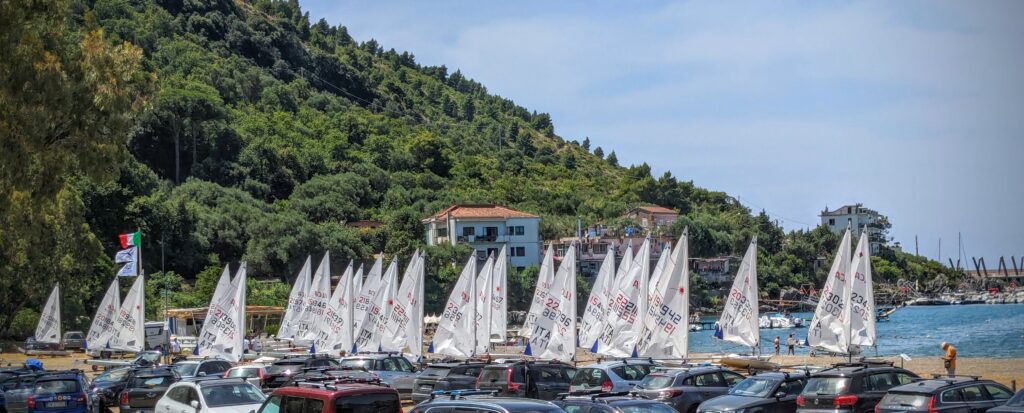
We found the “Circolo Nautica Sapri”. the Sapri Nautical Club, who were hosting the sailing competition, the ILCA Master. I couldn’t figure out what ILCA stands for tho.
It was getting hot so we headed back to our hotel and air conditioning. We have been in an “Excessive Heat Warning” basically since we left Tasmania at the end of April! Western Australia, Thailand, parts of Turkey, Greece and now Italy! We have also seen reports of several tourists in Greece who have died because they went hiking or walking in the extreme heat! We enjoyed a nice evening and had dinner at a resort restaurant across the street! Later, after dark, we were treated to another fireworks display!

Again, we have no idea what occasion prompted the show!
June15 Letojanni to Sapri (Day 262)
This morning we caught an early train to move north to our next destination, Sapri, on the west Mediterranean coast of Italy. We had to repeat our trip to Letojanni backwards; train to Messina, ferry across the Messina Strait to Villa San Giovanni, and train from Villa S. Giovanni to Sapri, a much smaller southern cousin of the Amalfi coast!

Another beautiful day to see the many beaches on the Mediterranean through the train window. We were happy for the air conditioning!
We reached Sapri and had a mile walk to our hotel.

Just outside the train station is the most modern church we’ve seen in Italy so far! Very interesting bell tower!
We headed to the waterfront, the Gulf of Policastro, to follow the promenade around the edge of the Gulf to our destination.
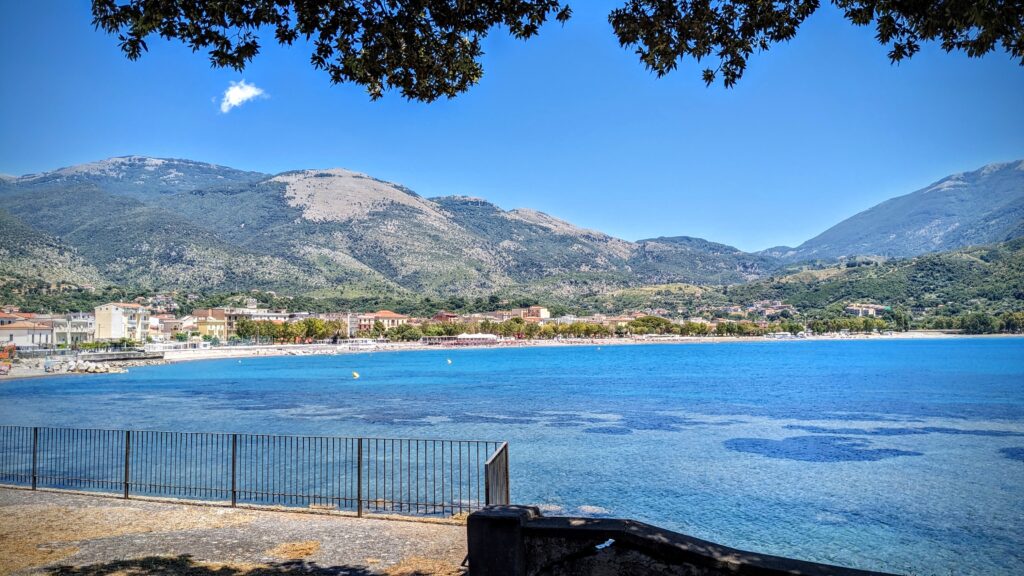
“Sapri is an elegant seaside town located on the border between Campania and Basilicata and set against a backdrop of green hills and majestic mountains overlooking the beautiful Gulf of Policastro. It has been a popular holiday resort since roman times, when Cicero called it “a small gem of the southern sea”.”

We passed this “Observatory” dedicated to science, across from the much older church.
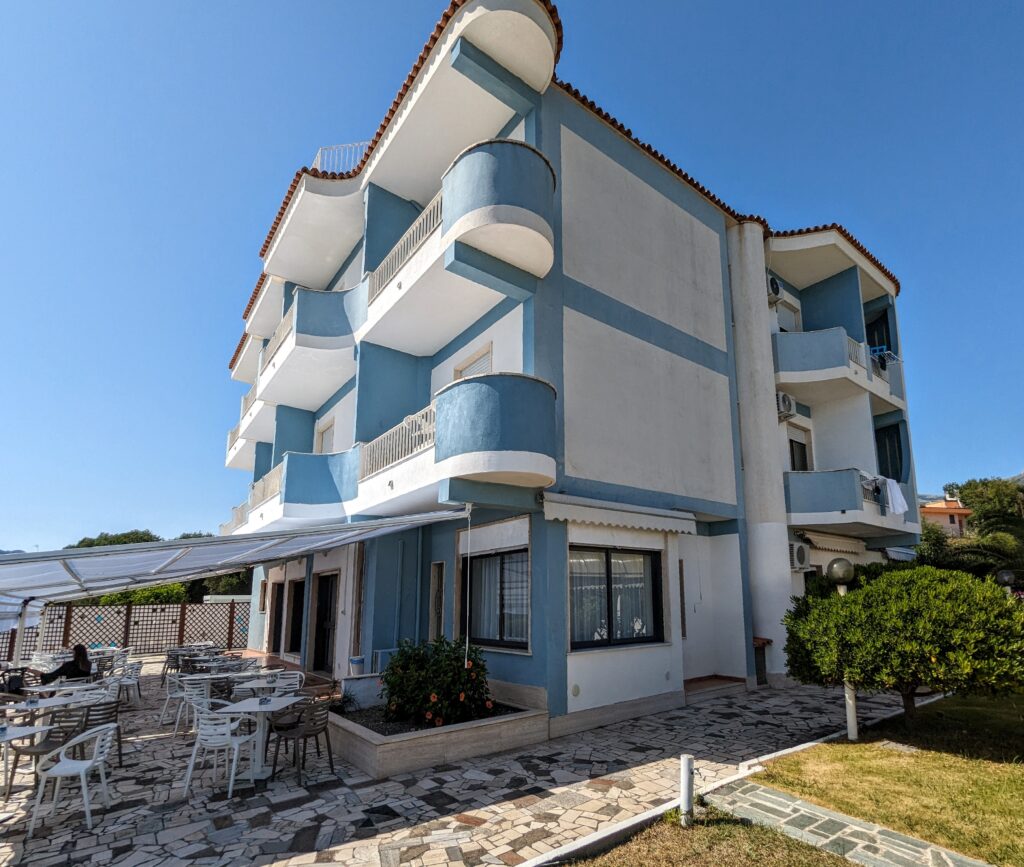
We finally reached our home for the next few days, Hotel Mediteranneo, next to a pebbly beach.
After settling in and showering after our walk, with backpacks on, and a nap, we were ready to explore the town a little more.

We walked back into town along the waterfront and noticed a flotilla of small sail boats out on the water (the tiny triangles of white on the right). They appeared to be in a competition of sorts, tacking around in a big circle with motorboats monitoring them.
We found a grocery store and purchased some fresh lettuce, tomatoes, peaches, balsamic glaze, pear juice and other munchies and headed back to make a wonderful salad for dinner. You can eat only so much pasta and pizza! While we were relaxing we heard booms and pops and sat out on the balcony watching a fireworks show, and it wasn’t even dark out yet!
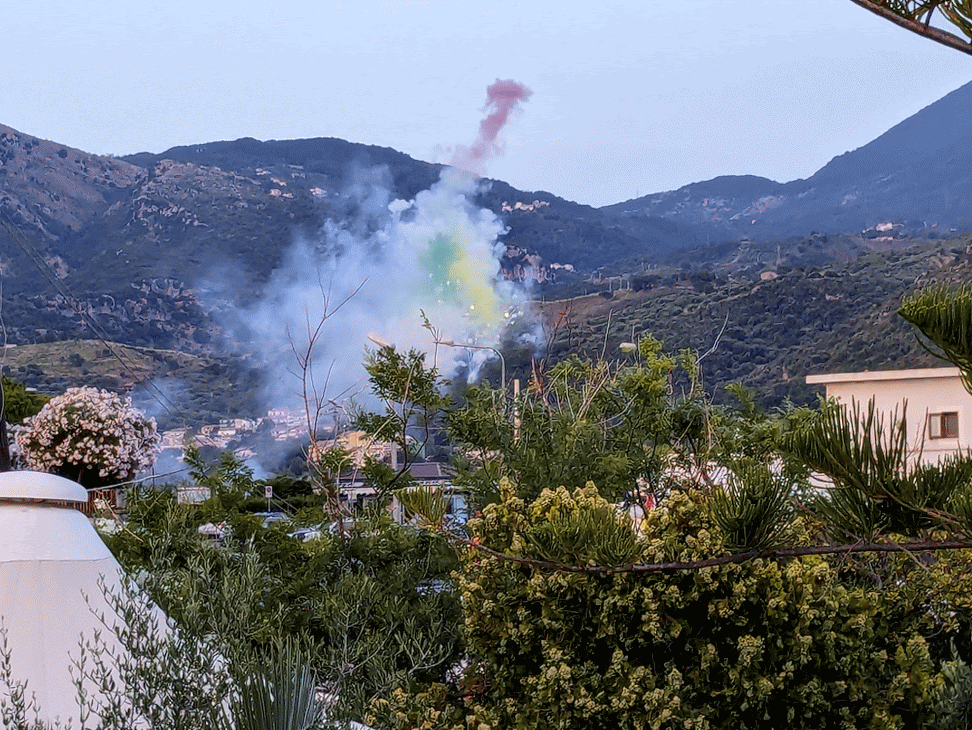
We never learned the occasion for the fireworks.
June 14 Catania (Day 261)
Today’s adventure is an hour long train ride to Catania, ‘Second City’ of Sicily, to explore this town shaped by Mt. Etna.
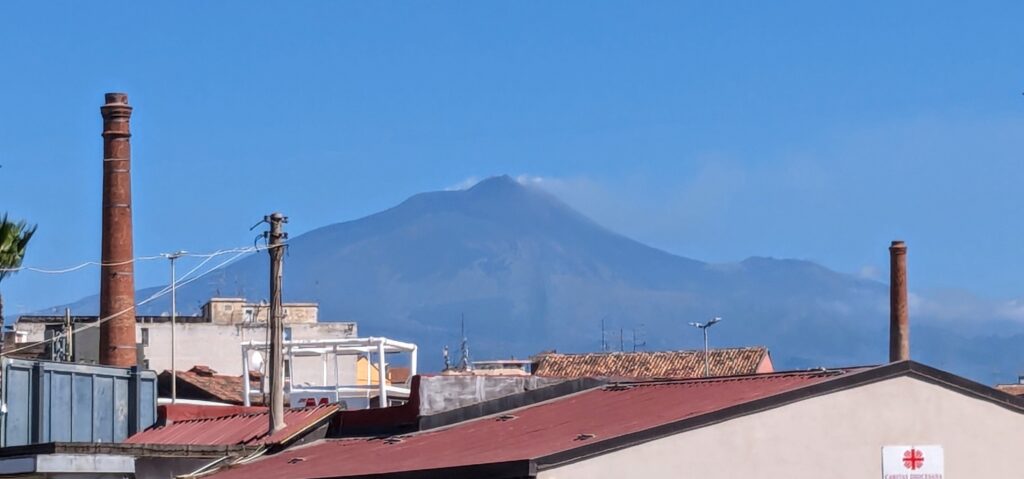
The largest town nearest the volcano, Catania has been settled since 800B.C.! We exited the train after passing through an industrial area. This is the best view of Mt. Etna we had all day!
We started walking along the waterfront with take-away coffees, then meandering our way down narrow streets towards the Piazza Duomo, the central square of the old town with the main cathedral.
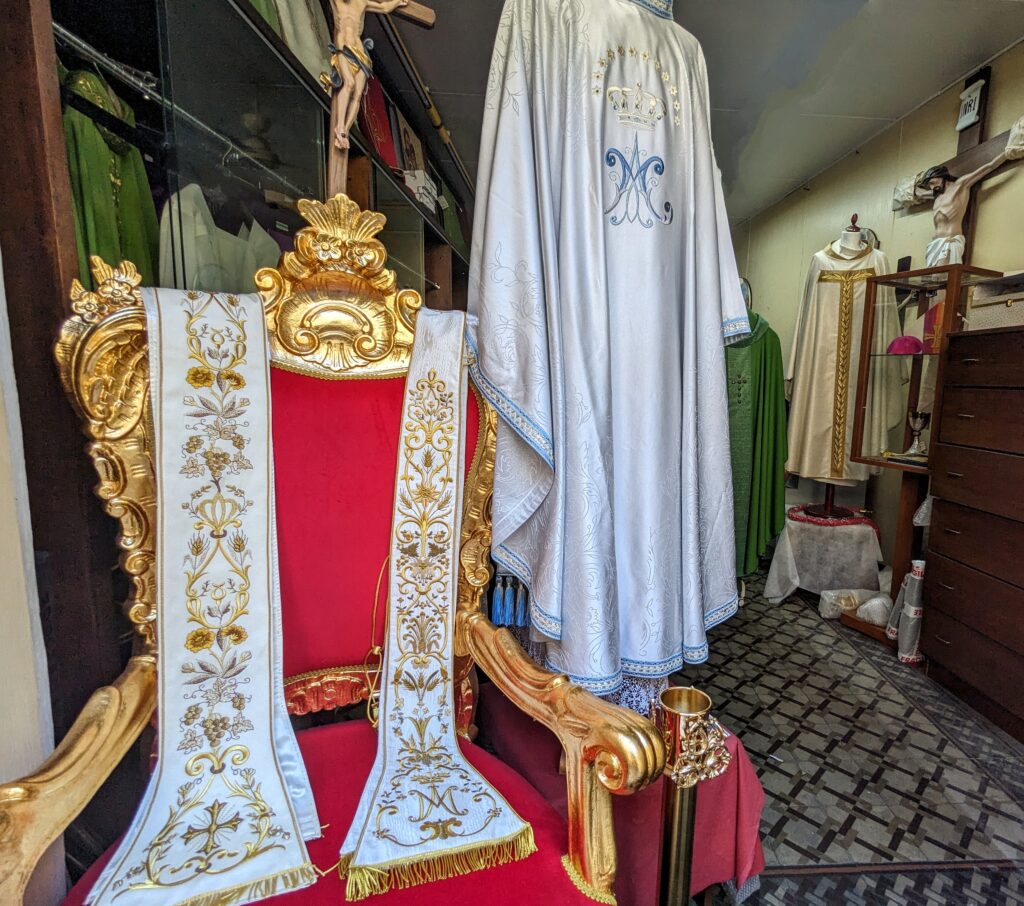
We knew we were getting closer when we passed this storefront. Is it where priests purchase their vestments? Is it a museum of priestly attire? We don’t know, it was closed.
Around the corner we found the church.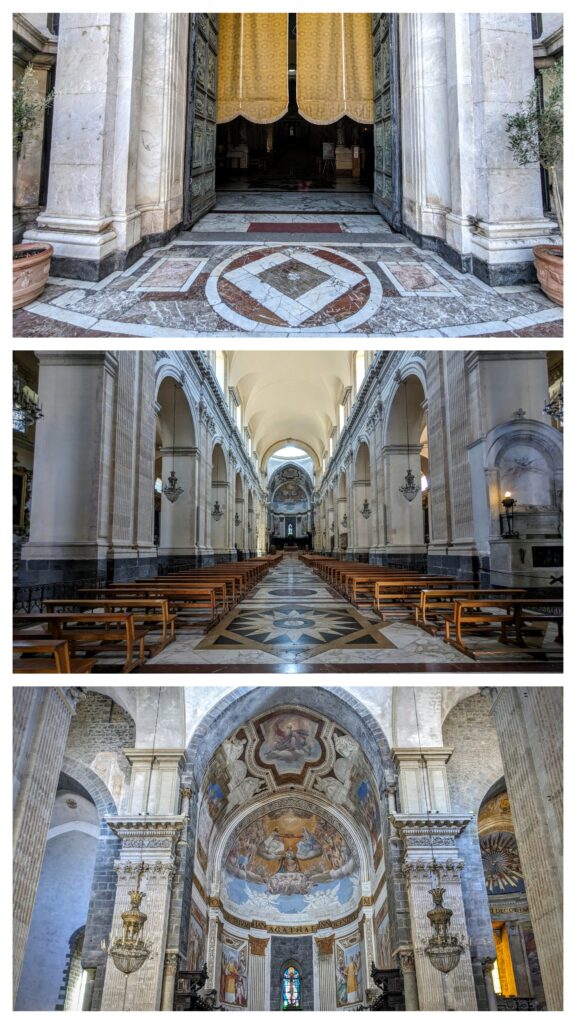
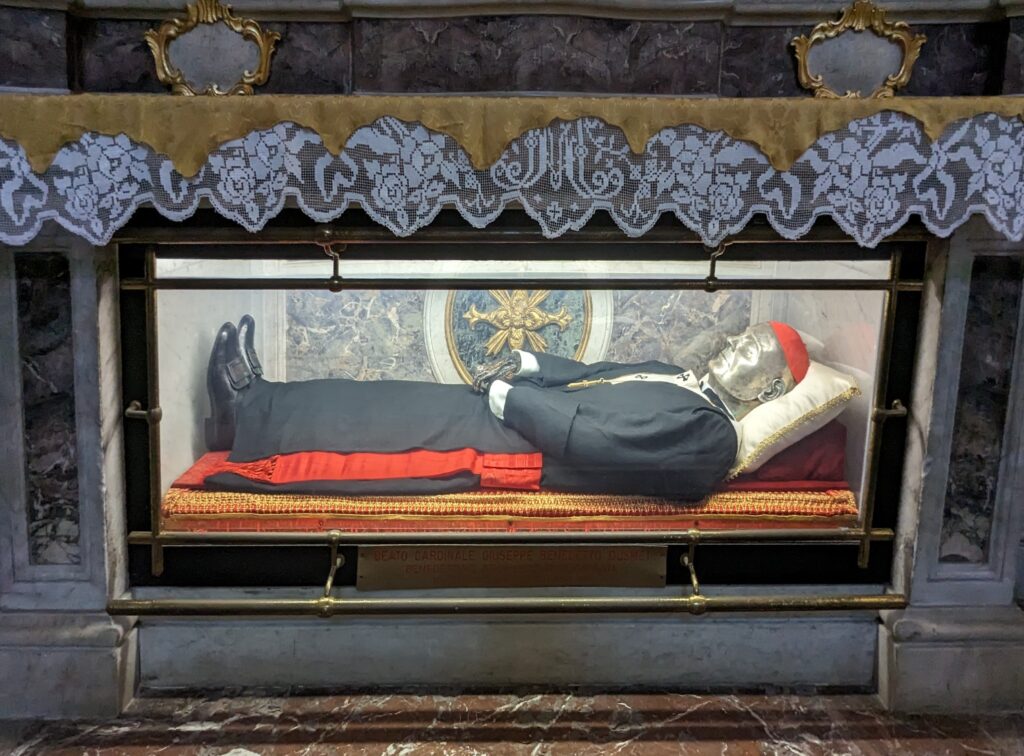
Ensconced in a side altar is the body of Cardinal Dusmet. Kind of creepy!
“In this altar you can find the remains of Blessed Cardinal Giuseppe Benedetto Dusmet… He was elected Archbishop of the city in 1867, then he was appointed Cardinal in 1888. He died in 1894 and from 1988, the year of his beatification, the body lies in this altar, exposed to the veneration of the devotees… He is also linked to the last famous miracle of the Veil of Saint Agatha, a relic that has always been considered by the people of Catania as a bulwark against the various natural calamities that have hit the city over the centuries: it was 1886 when Cardinal Dusmet ordered to carry the Veil in procession as a terrible eruption of Mount Etna was threatening the town. The Veil was carried in procession up to Nicolosi, a town that extends on the southern flank of Etna, and after days of prayer the lava front stopped.”
We continued our walk to the nearby Fish Peddlers Market, an open air fish and vegetable market near the square.

The bustle, the sounds, the smells! Unfortunately, it was too early to have fresh fish lunch!
Meandering around the old town took us past numerous churches, several closed permanently, many old ornate stone buildings, even ancient stone walls and towers! We came to a square with traffic flowing around the edges and an ancient Greek/Roman amphitheater, built of lava rock (being readily available from the many eruptions of Mt. Etna!) enclosed in the center.

Flanking one edge of the square (on the left) is the “Church of the Furnace”, supposedly the site of the martyrdom of St. Agatha, a 15 year old Christian in the 3rd century A.D. who was violently tortured on the rack, mutilated and burned for spurning the advances of a Roman Governor and keeping her vow of Christian celibacy. She is the patron saint of many places, especially Catania, also patron saint of burn victims, breast cancer patients, and rape victims.
A broad avenue from this site led us back to the Piazza del Duomo where we found a restaurant for lunch and a few more architectural gems.

The cathedral, now closed for the day, with the huge bronze doors shuttered.
We made our way back to the train station and got back to Letojanni in time to freshen up and enjoy our last dinner in town!
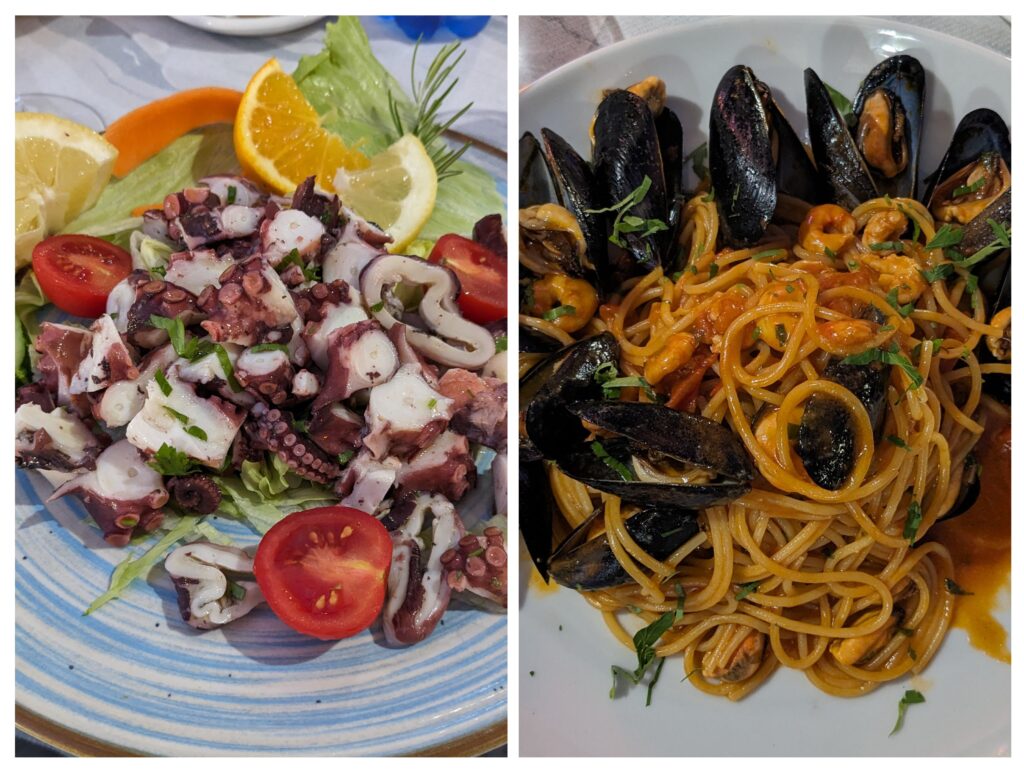
Octopus salad and mussels with spaghetti!
June 13 Taormina (Day 260)
After breakfast at the apartment we caught an earlyish train for the 5 minute ride to the next town south of us, Taormina. A tourist hotspot we’ve heard, due to the ancient Greek/Roman Theater at the center of the town situated up on the top of a hill. Arriving at the train station which is at the bottom of the hill, we opted to take the local bus up, rather than hike up in the already steamy heat! We walked into the picturesque town and purposely turned right rather than the left turn toward the theater. We found our way to a park overlooking the small bay of the Ionian Sea.

We got a great view down to the bay and out in the distance towards Mt. Etna.

The park is shaded by huge trees and filled with beautiful flowers.

And I got a closeup view of a sicilian wall lizard, maybe as common as our fence lizards back in Oregon.
Mt. Etna, the most active volcano on earth, overshadows Sicily and has been instrumental in the human history of the island! It and the Mediterranean climate are the reasons that agricultural products rule the economy and the food is stellar! It may be the reason the Greeks settled in the area and built the first theater on the top of the hill around the third century B.C.! Earthquakes and invasions damaged it and it was rebuilt by the Romans in the third century A.D.! It was rediscovered and excavated in the 1800’s and became a focus of “The Grand Tour” wherein young, wealthy, Englishmen mostly, traveled ‘the Continent’ to be educated on Greek & Roman history, culture and architecture.

Layer upon layer of culture, history and architecture!
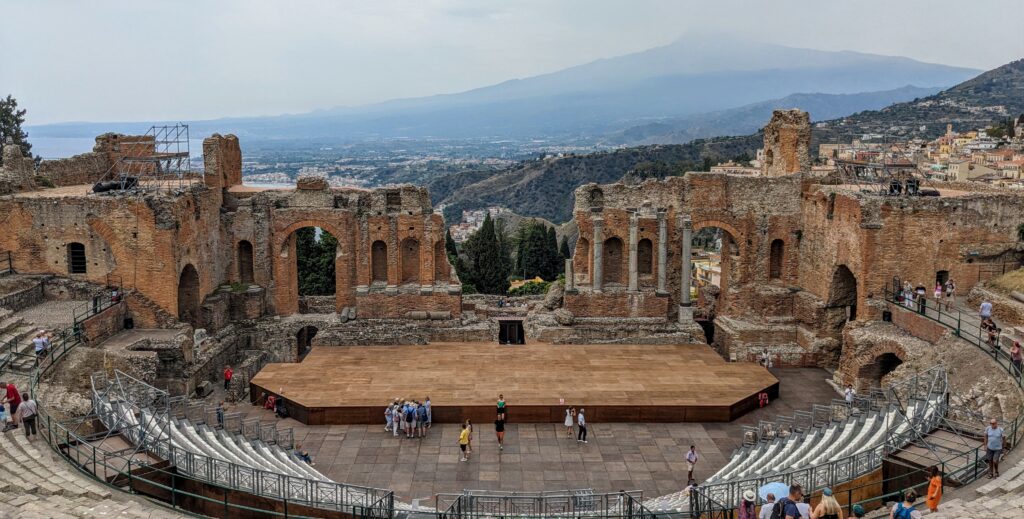
The stage from the ‘nosebleed section’. The theater is still used for concerts, operas and plays!
As the day went on into the afternoon the crowds increased and we decided to head home to laid-back Letojanni! We caught the bus back down to the train station and had some time to admire the restored station. It must have been a marvel when the elite travelers on the Grand Tour arrived back in the day!
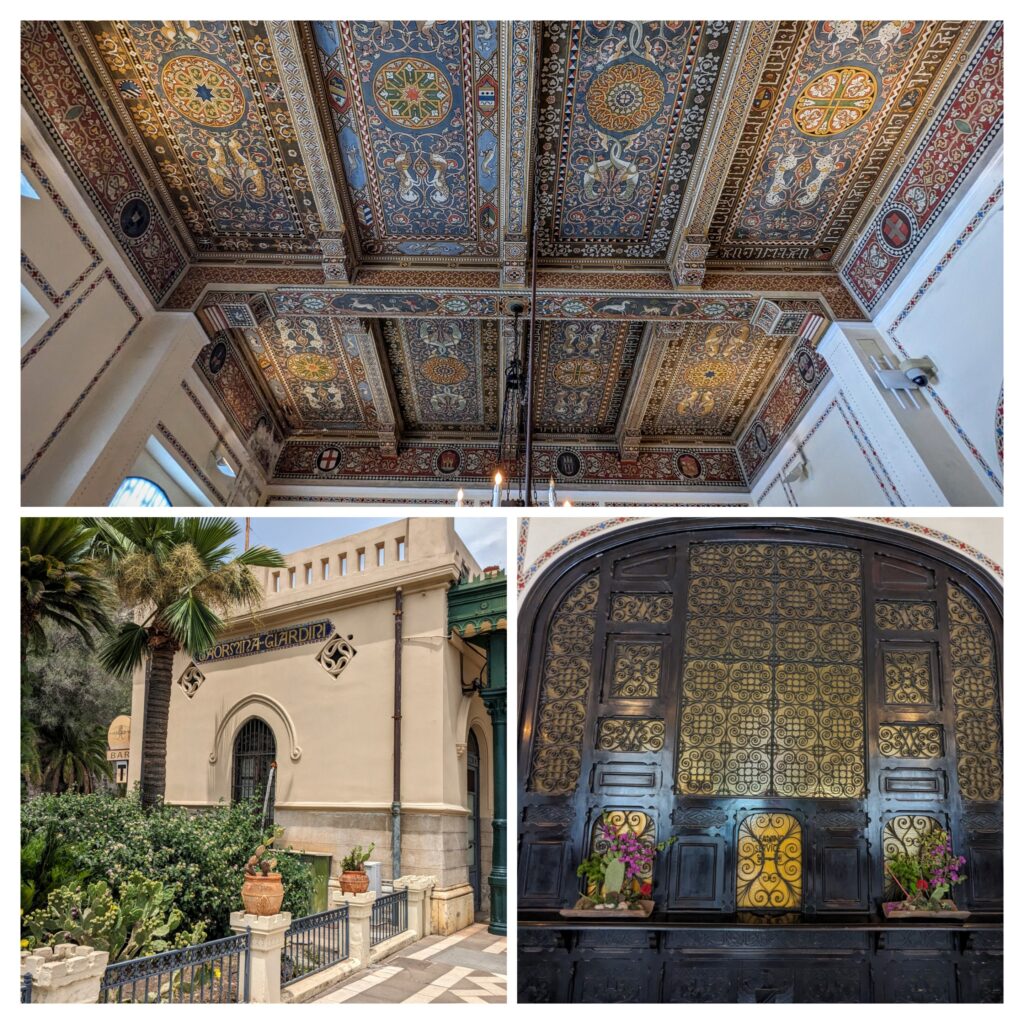
The painted ceiling and ornate grillwork reflect more recent artistic culture in the very colorful town!







































